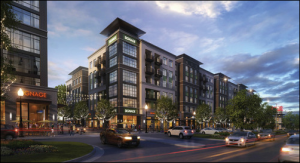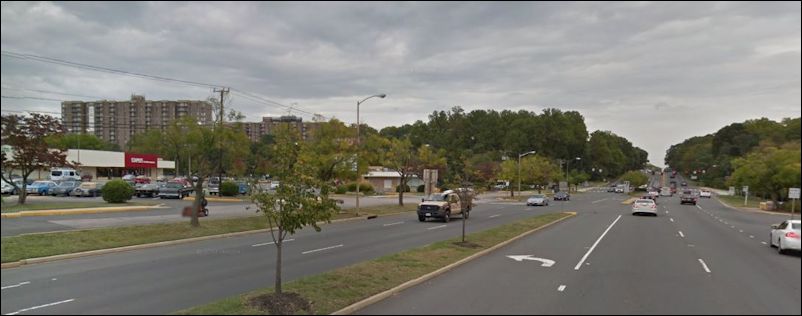Route 50 through the City of Fairfax is a classic stroad, a street-road hybrid, that originated as a state highway and degenerated into a local access road for commercial development, with the result that it serves neither function — moving cars or providing local access — especially well. In a lengthy stretch around Fairfax Circle, the “highway” is flanked by disconnected, low-density and low-value development such as gas stations, fast food, auto dealerships, shopping centers and the like. It’s typical of the “suburban sprawl” development that has dominated Fairfax City and County, and the rest of Virginia, since World War II.
At long last, the stars are aligned to re-develop much of this corridor as high-value, higher-density, mixed-use property that will fill the city’s coffers with greater tax revenue at little offsetting cost — and create an attractive place where people are more likely want to live and do business.
 On Tuesday, City Council approved a plan by Combined Properties build two apartment buildings with 400 units, ground-floor retail, and a 54,000-square-foot grocery store. Structured parking will replace large parking lots. Expanded sidewalks, buffers and a frontage road with parallel parking will create a pedestrian-friendly environment. While the plan has imperfections, the results will be vastly preferable to what’s there now.
On Tuesday, City Council approved a plan by Combined Properties build two apartment buildings with 400 units, ground-floor retail, and a 54,000-square-foot grocery store. Structured parking will replace large parking lots. Expanded sidewalks, buffers and a frontage road with parallel parking will create a pedestrian-friendly environment. While the plan has imperfections, the results will be vastly preferable to what’s there now.
Fairfax Circle typifies the re-development that is taking place in “suburban” counties across Virginia and much of the country. As I explained in “The Evolution of the Burbs,” suburban jurisdictions are selectively urbanizing. Low-value commercial property on major thoroughfares like Rt. 50 (Lee Highway) will be re-developed in mixed uses, at higher densities, with more walkable surroundings, often with access to mass transit. (Fairfax Circle is within walking distance of the Vienna Metro.) Yes, growth is occurring in the “suburbs” but it’s looking more like Fairfax Circle and less like the shopping centers and cul-de-sac subdivisions of yore.
Cities and counties can either allow this re-development to occur in a haphazard way, or they can create a planning framework for the pieces to fit together. The City of Fairfax completed but never passed a Fairfax Boulevard Master Plan. As Douglas Stewart writes in Greater Greater Washington:
Many of the project’s shortcomings stem from the fact that Fairfax City still does not have a clear plan for Fairfax Boulevard. An adopted plan that sets forth clear guidelines for street connectivity, green infrastructure, affordable housing and other elements would make the process easier for applicants and more beneficial for the city.
Rules governing street connectivity and storm-water infrastructure are essential to ensure that future projects integrate harmoniously with Fairfax Circle. An affordable housing component is more problematic; it will add costs, creating a higher financial burden for re-development without really addressing the affordability issue. (See Emily Washington’s essay, “How Affordable Housing Policies Backfire.”) Be that as it may, we’ll be seeing a lot more development like this and, for the most part, that’s a good thing.



